Key Points and Summary – The Su-27 Flanker was born to counter the F-15 and restore Soviet confidence in air superiority.
-After a difficult start, Sukhoi redesigned the T-10 into a big, agile, long-range fighter with fly-by-wire, powerful AL-31F engines, and blended aerodynamics that made it deadly up close yet stable at range.
-It entered service in the late 1980s, guarded vast frontiers, and spread widely abroad—most notably to China, where it seeded the J-11 line.
-Upgrades (Su-27SM/SM3) modernized sensors and weapons. Its DNA produced the Su-33, Su-34, and Su-35.
-Aging but adaptable, the Su-27 remains a reference point for modern Russian fighter design.
-BONUS: We included several original photos from our time with a Su-27 Flanker at the U.S. Air Force Museum back in July of this year.
Su-27 Flanker: The Soviet Answer To The Eagle
By the mid-1970s, U.S. airpower had shifted the balance with the F-15 Eagle—a large, long-range, high-altitude air-superiority fighter carrying a powerful radar and new generations of beyond-visual-range missiles. The Soviet response couldn’t be incremental; it had to be decisive. Moscow wanted a fighter that could match or overmatch the Eagle in energy maneuverability, outlast it with fuel and range over the USSR’s vast defensive frontiers, and operate as part of an integrated air-defense system with ground radars and look-down/shoot-down capability.
Soviet planners split the requirement into a heavy/light team. The heavy fighter would be Sukhoi’s domain—long-range, high endurance, and large sensors to dominate beyond the merge—paired with Mikoyan’s lighter MiG-29 for frontline work. The heavy half became the Su-27.
From T-10 To Su-27: Redesigning A Winner
Sukhoi’s initial T-10 prototypes revealed the right ambition but the wrong execution. Early aerodynamics and control laws produced stability and handling issues as the design chased both range and agility. Instead of forcing a flawed airframe into service, the bureau conducted a deep redesign—reworking the wing planform, engine placement, and flight-control system. The result, sometimes called T-10S, was the Su-27 we recognize today: a big, blended lifting body with a wide-spaced engine layout, twin vertical tails, and expansive leading-edge root extensions (LERX) that generate strong vortices at high angle of attack.
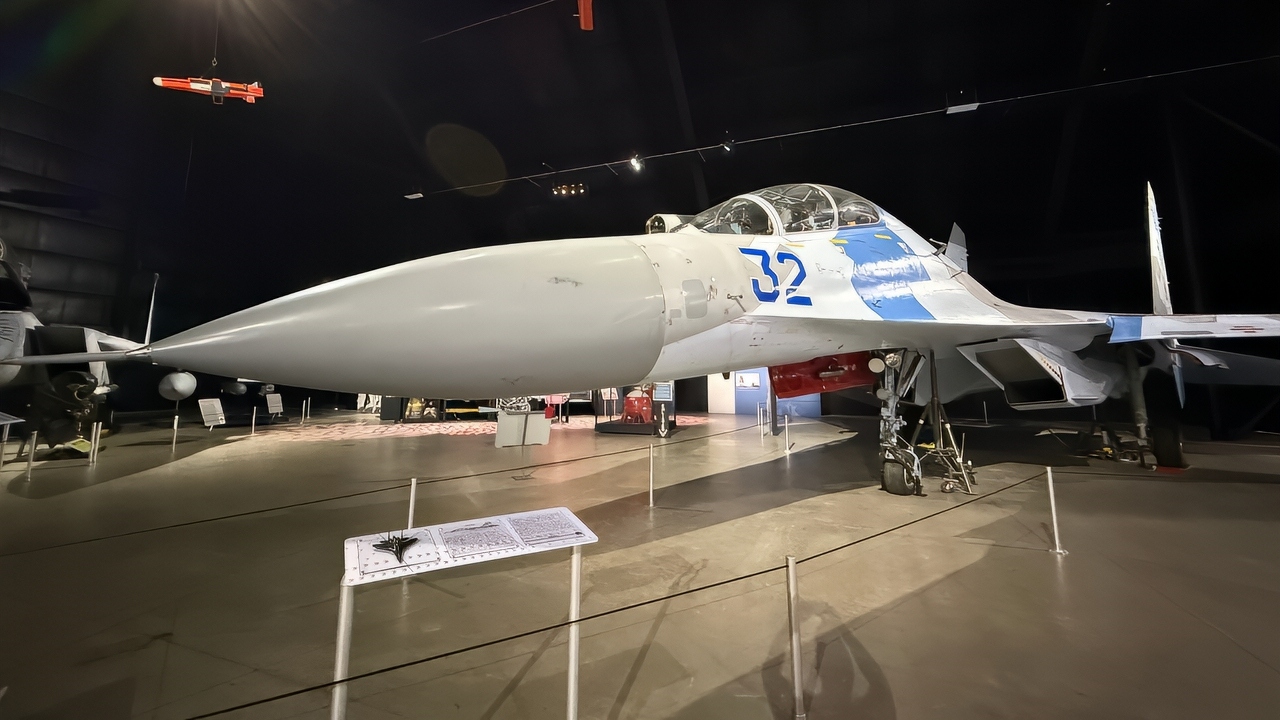
Su-27 Flanker Up Close. Image Credit: National Security Journal Taken on July 19, 2025.
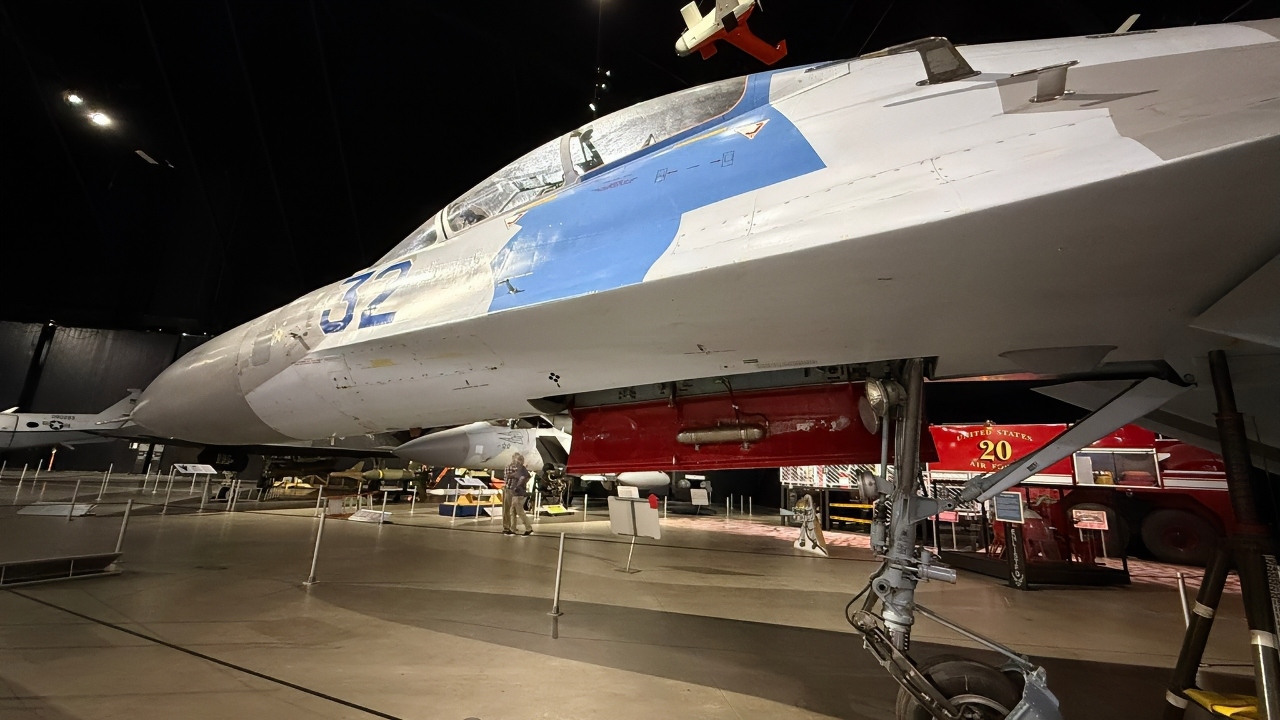
Russian Su-27 Flanker from USAF Museum. Image Credit: National Security Journal.
Behind the shape sat digital fly-by-wire, an advanced step for Soviet industry at the time. FBW let engineers trade traditional stability margins for controlled instability, unlocking crisp pitch/roll response without making the jet twitchy or unsafe. Combined with high-lift devices and the vast lifting fuselage, the Su-27 could hold energy in sustained turns, snap to high alpha for nose-pointing, and still feel predictable to a trained pilot.
Engineering The Flanker: Big Airframe, Big Muscles, Big Sensors
Three pillars define the Su-27’s engineering philosophy:
Propulsion. Twin AL-31F turbofans gave high thrust-to-weight and strong acceleration, critical for fast climbs and quick reattacks. The wide nacelle spacing created a large centerline weapons/fuel volume and contributed to yaw stability.
Aerodynamics. A blended wing-fuselage and powerful LERX kept the wing fed with energetic airflow in aggressive maneuvers, preserving lift where older designs would stall. Twin tails provided authority at high angles of attack.
Avionics & Sensing. The Su-27 carried a large pulse-Doppler radar for look-down engagements and an infrared search-and-track (IRST) set ahead of the canopy for passive detection. The pairing let pilots prosecute targets without always radiating. A helmet-mounted sight cued high off-boresight short-range missiles, while medium-range R-27 variants (semi-active radar or infrared) extended reach.
Designers also built in range: generous internal fuel and efficient cruise let the Su-27 patrol long border sectors or escort strike packages—roles where endurance wins fights before missiles do.
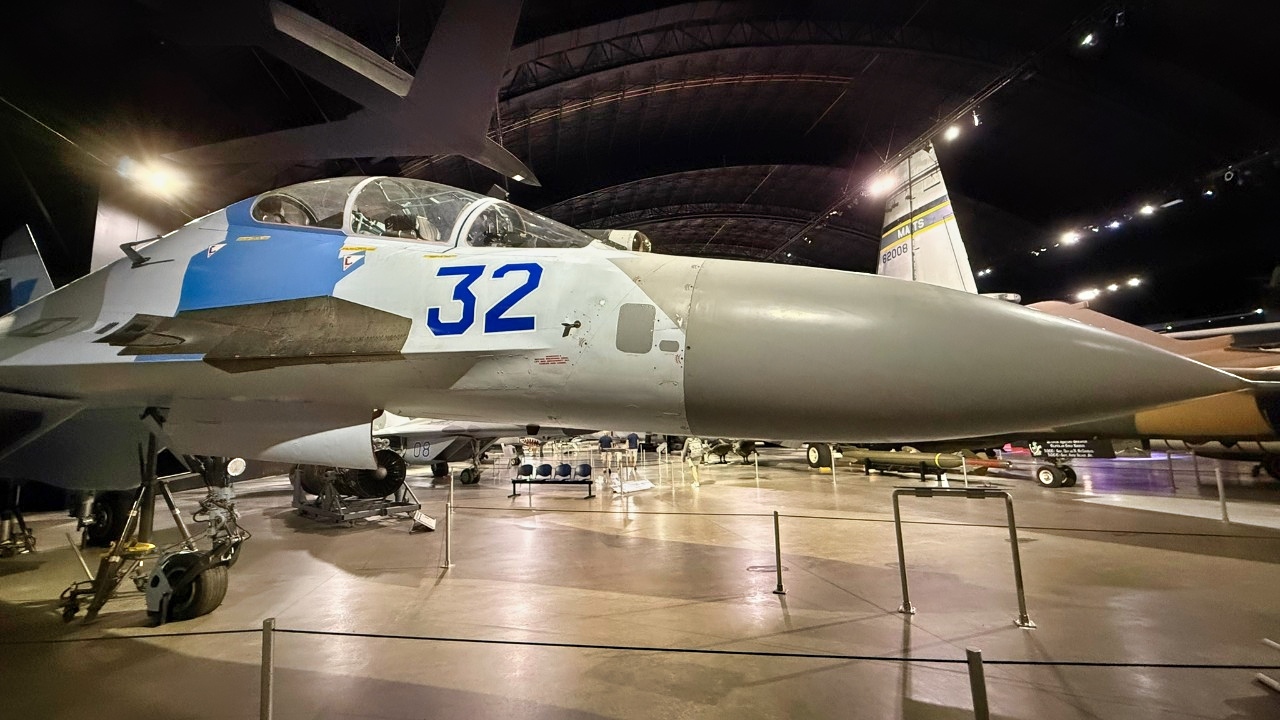
Su-27 Flanker Fighter from Russia. Image Credit: National Security Journal.
Entering Service: Recasting Soviet Air Superiority
The Su-27 began reaching regiments of the PVO (Air Defense Forces) and later the Tactical Aviation arm in the late 1980s. It quickly became the high-end guardian of Soviet airspace—scrambling to meet reconnaissance flights, patrolling the northern and far-eastern approaches, and training for offensive counter-air sweeps in the European theater.
Pilots found a rare blend: big-fighter legs with knife-fight agility. The Flanker could arrive with fuel, dictate altitude, and still hold its own in the visual merge. Demos like the famous Cobra (a dramatic but tactically specialized pitch maneuver) showcased controllability; the operational value was subtler—confidence at high alpha without departure, letting the pilot point weapons where it mattered.
Export Story: From Russia To A Dozen Air Arms—Especially China
After the Soviet collapse, the Su-27 became both a currency earner and a strategic export. The most consequential customer was China. Initial deliveries of Su-27SK/UBK aircraft were followed by a license-production deal that created the J-11 line. Chinese industry then moved from kit assembly to progressively more indigenous variants (J-11B and beyond), swapping sensors, electronics, and weapons. The Su-27 thus seeded an entire Chinese heavy-fighter family that still evolves today.
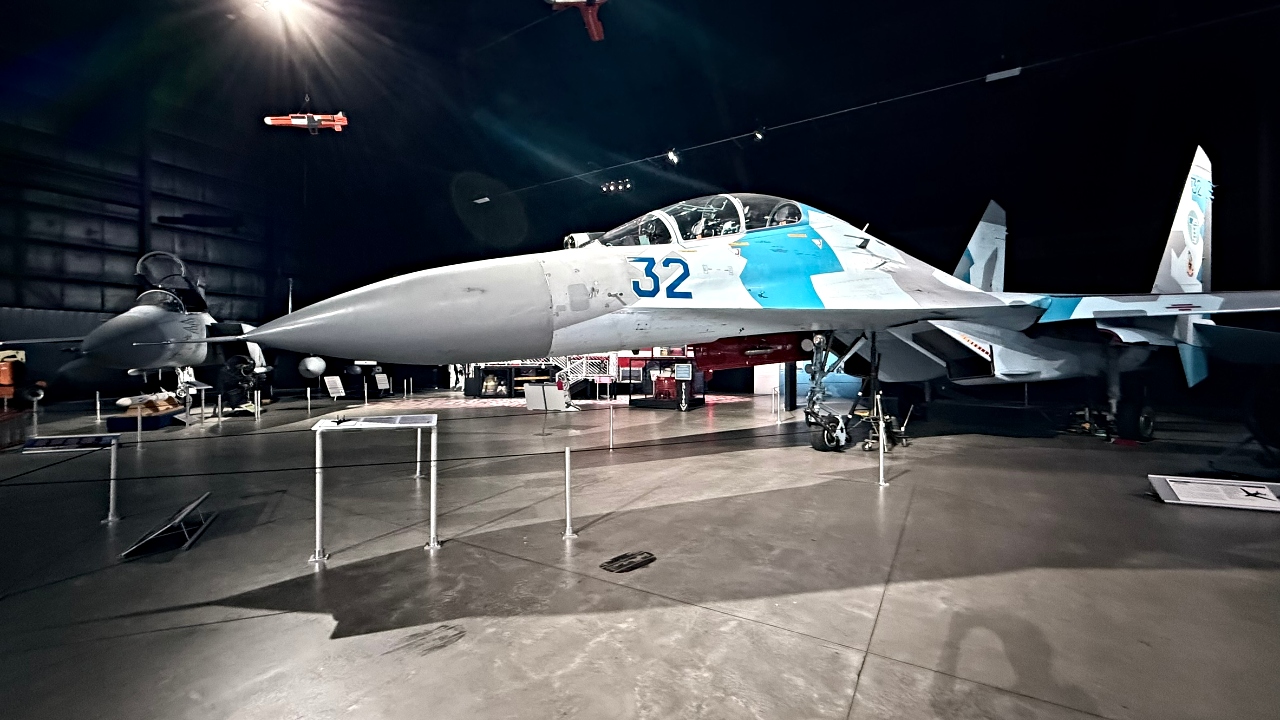
Su-27 Flanker from U.S. Air Force Museum. Image Credit: National Security Journal.
Elsewhere, the Flanker went to Vietnam, Indonesia, Ethiopia, Angola, Eritrea (via variants), and parts of the former Soviet Union. India opted for the Su-30 family rather than baseline Su-27s, but the lineage is direct—Su-30s are two-seat, multirole expansions of the same airframe DNA.
Operational History In Brief
The Su-27’s wartime résumé is uneven because many operators used it primarily for deterrence and air policing. Where it fought, it left marks:
Horn of Africa (1998–2000). Ethiopian Su-27s clashed with Eritrean MiG-29s, with the Flankers widely credited with the upper hand thanks to better radar performance, training, and missile employment.
Post-Soviet Space. Successor states flew Su-27s for air defense and exercises; some saw limited combat air patrols in regional crises.
Ukraine (since 2014, and especially after 2022). Ukrainian Su-27s have flown air-defense and strike-escort roles under extreme threat, highlighting the type’s endurance and agility but also the modern reality: survival depends on networks, sensors, and counter-SAM tactics as much as the airframe.
In all cases, the lesson is consistent: the Su-27 is potent, but its edge grows or shrinks with avionics health, pilot proficiency, tactics, and integration with ground-based radars and AWACS.
The Upgrade Arc: Keeping The Classic Relevant
To keep pace with digital adversaries, Russia fielded a suite of Su-27SM/SM2/SM3 upgrades that modernized the cockpit and mission systems:
Sensors. Improved multimode radars with better reliability and look-down performance; refreshed IRSTs with higher sensitivity.
Weapons. Integration of active-radar R-77 class missiles, improved R-27 variants, and modern precision air-to-surface munitions—transforming the Su-27 from pure air-superiority into a limited multirole platform.
Cockpit. Glass displays, updated navigation, and data links to share the air picture and receive target updates.
Electronic Warfare. New ECM/ESM suites to complicate enemy intercepts and missiles.
Export users pursued parallel paths—some modest, some deep—depending on budgets and access. Where funding allowed, upgraded Flankers became credible 4-generation fighters into the 2010s.
Variants And Branches: A Family Tree, Not A Single Jet
The Su-27’s greatest achievement may be as a platform:
Su-27S/P. Single-seat baseline air-superiority models (S for front-line, P for air-defense) that defined the fleet in the late 1980s and 1990s.
Su-27UB. Two-seat combat-trainer with full-fidelity handling; its stretched fuselage later enabled true multirole evolutions.
Su-33. The carrier-capable derivative with canards, strengthened gear, and navalized systems for STOBAR operations—evidence the core aerodynamics could adapt to sea-based demands.
Su-30 Family. Twin-seat, long-range multirole developments (various national sub-lines) that added air-to-ground depth while retaining air-superiority traits.
Su-34. The strike-centric branch (see below).
Su-35. The top-end 4++ upgrade path (see below).
It’s rare for a fighter to support so many credible derivatives across three decades. The Flanker did.
How The Su-27 Influenced The Su-34 And Su-35
Su-34 “Fullback.” Born as the Su-27IB, the Su-34 reworked the front fuselage into a side-by-side cockpit for long-range strike crews, added a robust radar and EW suite, reinforced the airframe for low-level penetration, and preserved the Flanker’s fuel fraction and agility. The result is a bomb-truck that can still fight its way out—a strike aircraft with fighter roots, not a bomber that hopes to run.

Su-34 Fullback from Russia. Image Credit: Creative Commons.

Sukhoi Su-34 Heading Into the Sky. Image Credit: Creative Commons.
Su-35 (often Su-35S in service). This is the Su-27 pushed to its technological limits: digitized flight controls, thrust-vectoring engines, reduced-signature shaping in select areas, a powerful passive/active sensor mix, and modern EW. It retains the Flanker’s big-airframe advantages—fuel, payload, and agility—while making the jet far more lethal in the BVR arena and more survivable against modern threats. If the Su-27 was the answer to the F-15 of the 1970s, the Su-35 is Russia’s answer to late-generation F-15/16 and a hedge against fifth-gen adversaries it cannot yet match numerically.
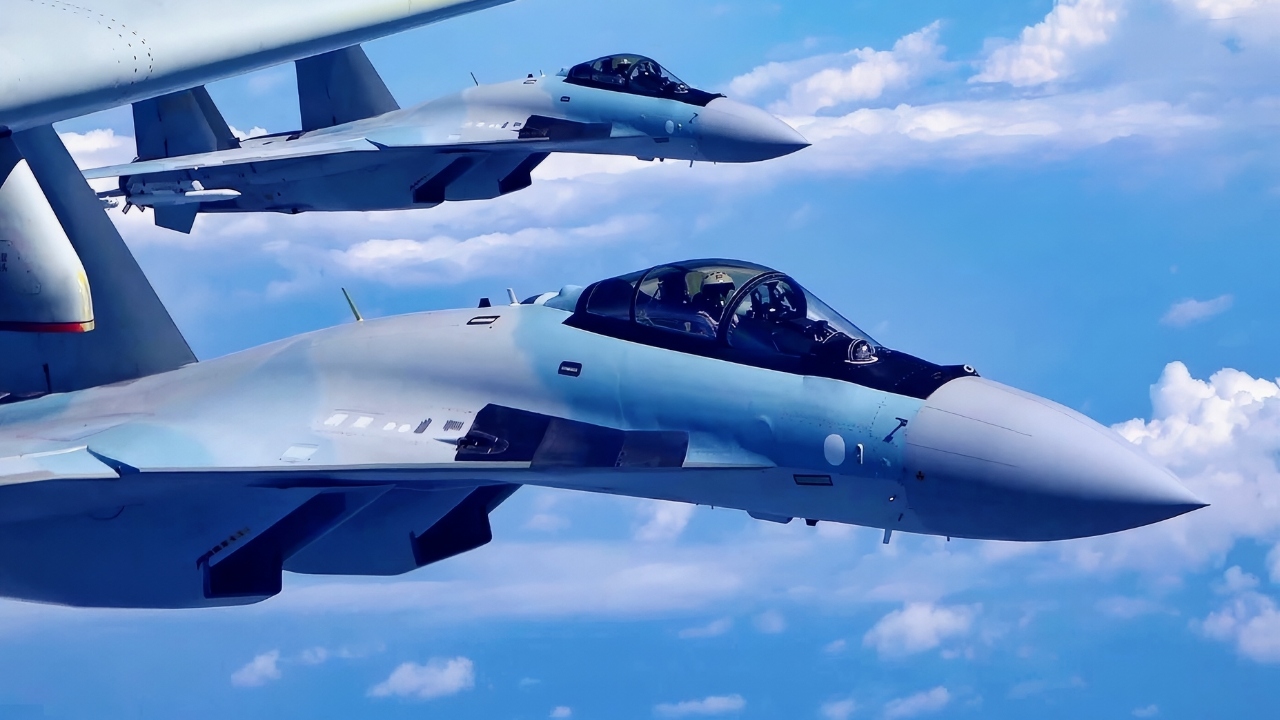
Su-35 from China. Image Credit: Chinese Air Force PLAAF.

Sukhoi Su-35 Fighter. Image Credit: Creative Commons.
China’s Take: From Su-27SK To Indigenous Families
Chinese adoption went beyond simple operation. The Su-27 accelerated industrial learning: airframe assembly, systems integration, maintenance practices, and, eventually, indigenous substitution of avionics, sensors, and weapons. The J-11 family diverged as China replaced Russian components with local ones, then added air-to-ground multirole depth and different cockpits and pylons. That fork in the tree fed into China’s later designs, which echo the Su-27’s strategy of big airframes with long legs, strong sensors, and agility.
What Made The Su-27 Good—And Where It Struggles Today
Enduring Strengths
Kinematics. High thrust, efficient aerodynamics, and a forgiving high-alpha envelope give the pilot tactical options—entry, exit, reattack—many jets can’t match.
Range. Internal fuel and efficient cruise mean time on station—vital for air policing and escort.
Sensor Diversity. Radar + IRST + helmet sight was a forward-leaning combo when introduced and still valuable for passive tactics.
Growth Margin. The large airframe accepts new avionics, antennas, and cooling—hence decades of credible upgrades.
Modern Limits
Signature And Survivability. Against networked IADS and modern AESA-equipped opponents, a fourth-gen airframe’s RCS and emissions profile demand top-tier EW and tactics.
Avionics Aging. Without deep modernization, legacy radars and mission systems struggle in clutter, jamming, and multi-target scenarios.
Weapons Integration. The jet’s potential hinges on modern missiles and seamless data links; operators without them don’t see the Flanker at its best.
The Su-27’s Place In Combat Doctrine
At its heart, the Su-27 was designed to arrive first with energy and set terms—use speed and altitude to dictate merges, or hold standoff and punish intruders. In Soviet doctrine it fought within a network: ground controllers, long-range surveillance radars, and cooperating fighters. The jet thrives when that network is healthy. When it’s not—when pilots fight piecemeal or with sick radars—its advantages erode. That duality explains the mixed combat record: the airframe is formidable, but context decides outcomes.
The Future: Sunset, Side-grade, Or Second Life?
The baseline Su-27 fleet is aging. Russia increasingly leans on Su-35S for high-end tasks and is inducting Su-57 in small numbers. Many export users face the same decision tree:
Life-Extension + Avionics Refresh. Where budgets are tight, upgraded Su-27s (new radar/IRST, digital cockpit, EW, and weapons) can stay relevant for air policing and regional deterrence.
Migration To Derivatives. Others shift to Su-30 or Su-35 for better multirole performance and survivability.
Replacement. A few will pivot to non-Russian types, especially as supply chains and sanctions complicate spares and upgrades.
What’s unlikely is a clean-sheet Su-27 replacement from Sukhoi; the lineage has already evolved. The Flanker will fade progressively from front lines, but its derivatives will keep its spirit alive well into the 2030s.
Legacy: A Design That Birthed A Dynasty
The Su-27 changed how the Soviet—and later Russian—fighter community thought about air superiority. It proved that size and agility are not opposites; that a big fighter can still dance if you give it FBW and the right aerodynamics; and that range is combat power, not just convenience.
Its greatest legacy is the family it created. Su-33 took it to sea. Su-34 turned it into a deep-strike machine. Su-30 made it a long-range multirole partner for dozens of air forces. Su-35 showed how far fourth-gen can be stretched. Even aircraft that compete with it abroad borrowed ideas it normalized: blended lift, high-alpha control, helmet cueing, IRST, and the relentless use of growth margin.
The Su-27 was built to dethrone an American icon. In doing so, it became one itself—less a single fighter than a design language that still shapes Russia’s combat aviation.
About the Author: Harry J. Kazianis
Harry J. Kazianis (@Grecianformula) is Editor-In-Chief and President of National Security Journal. He was the former Senior Director of National Security Affairs at the Center for the National Interest (CFTNI), a foreign policy think tank founded by Richard Nixon based in Washington, DC. Harry has over a decade of experience in think tanks and national security publishing. His ideas have been published in the NY Times, The Washington Post, The Wall Street Journal, CNN, and many other outlets worldwide. He has held positions at CSIS, the Heritage Foundation, the University of Nottingham, and several other institutions related to national security research and studies. He is the former Executive Editor of the National Interest and the Diplomat. He holds a Master’s degree focusing on international affairs from Harvard University.
More Military
Iowa-Class Battleship USS Wisconsin Has a Message for the U.S. Navy
‘Apex Predator’: The Royal Navy’s New Astute-Class Submarine Is Quiet as ‘Baby Dolphin’
Aircraft Carrier USS Carl Vinson Has a Message for the U.S. Navy
Europe’s Future Combat Air System (FCAS) 6th-Generation Fighter Is Officially in Trouble
The Royal Navy’s Dreadnought-Class SSBNs have a Message for Russia










